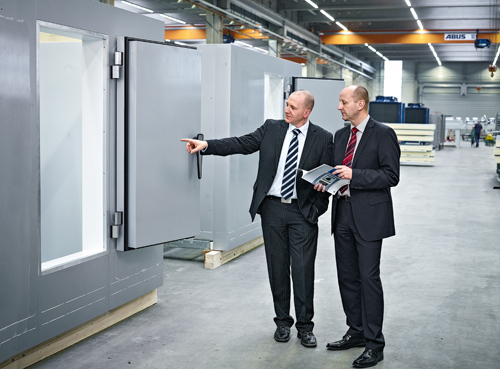Ever more frequently, large refrigeration chambers are equipped with centralised air coolers. A special type is made by the thermofin company, from Heinsdorfergrund in the German state of Saxony. “An insulating cooler is, in principle, a container with flaps, into which a cooling unit is built,” explains Michael Hanning, Regional Director of the ebm-papst outside sales office in Halle/Saale. The device is located outside the refrigeration chamber. From there, the insulating cooler is flange-mounted on the cold storage area. The refrigeration that the insulating cooler transfers into the air is then led through the opened flaps into a duct, and from there into the cold storage area. In this way, no space is lost in the storage area itself, and there is more space for shelves and merchandise. As has long been common in insulating coolers, the company used double-flow centrifugal fans with belt drive and frequency inverter for this application.
Idea during tour
All that changed as a result of a visit from Michael Hanning and his sales colleague Martin Schulz, who together toured production with Frank Müller, Technical Manager at thermofin. During it, the ebm-papst employees noticed the belt-driven AC fans installed in the insulating cooler. “We suggested thinking about a backward-curved GreenTech EC fan, because the device could be significantly more efficient that way,” Hanning remembers. The suggested solution, however, required a revision of the insulating cooler and the corresponding skills and knowledge. Technical enthusiast Müller fancied the idea, and agreed to look into the option in detail.“
First we had to find out what components we needed for the replacement of the belt-driven fans,” Müller remembers. Then, ebm-papst sent 3D data, with which the Technical Manager and his team could redesign the insulating cooler on the computer and compare various arrangements of the fans within the device. The effort led to an ideal solution: Alongside efficiency and ease of maintenance, the air conduction and the cleaning options of the heat exchanger were significantly improved. After the theoretical design on the computer was completed, ebm-papst delivered a sample of the centrifugal fan for a prototype. The tests and measurements confirmed significant energy savings.
The pay-off for the work
While the input power of the insulating cooler with the belt-driven AC fans was just under 27 kilowatts, it is now only 17 – a whole 37 percent lower. And the noise level was also reduced by 4.5 decibels. In addition, the insulating cooler became more reliable: Lubrication intervals are omitted, which makes service easier – and through the omission of the belt, slip losses are a thing of the past.The new design with the GreenTech EC fans could be implemented at thermofin almost cost-neutrally compared to the conventional solution, and the renovation brought additional positive effects with it. Due to the high efficiency of the system, the company was awarded the contract for equipping the cold storage warehouse for a large German supermarket chain.
The new end product, used for the first time, is thus perfectly suited for the market; as a result, thermofin secured protective rights for the combination of components. “One particularly nice thing about the project was that the customer agreed to the renovation of the insulating cooler, and in the end, we were all rewarded by the fact that the hoped-for savings was achieved,” Hanning summarises.


Leave a comment